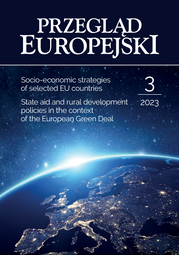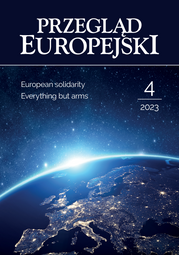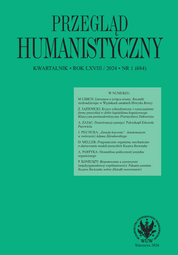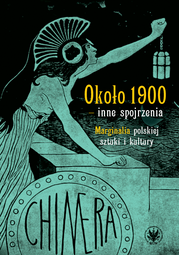Information about a product
| Edition: | 1 |
| Place and year of publication: | Warszawa 2024 |
| Publication language: | polski |
| ISBN/ISSN: | 978-83-235-6593-2 |
| EAN: | 9788323565932 |
| Number of page: | 178 |
| Binding: | Miękka |
| Format: | 17x24 cm |
| Method of publication: | Druk |
| Weight: | 330 g |
| Publication type: | Praca naukowa |
| DOI: | https://doi.org/10.31338/uw.9788323564027 |
Around 1900 – Other Perspectives. Marginalia of Polish Art and Culture
Young Poland is one of the most popular periods of our history of arts. It is evidenced by a multitude of scientific studies, artists’ monographs, exhibitions, albums. Looking further, however, one might notice countless white spots, forgotten or yet undiscovered phenomena, especially outside of the mainstream of “big names” and important centres. Immeasurable as of yet, field of marginalia requires constant exploration, profound look into then popular painting, social and economic functioning of the world of arts (including graphics and architecture), writing of creators that are not necessarily considered critics or art theoreticians till this day.
Keywords: modernism, turn of the 19th century, new media, visual arts, creative experiments, technological innovation, artistic education.
Young Poland is one of the most popular periods of our history of arts. It is evidenced by a multitude of scientific studies, artists’ monographs, exhibitions, albums. Looking further, however, one might notice countless white spots, forgotten or yet undiscovered phenomena, especially outside of the mainstream of “big names” and important centres. Immeasurable as of yet, field of marginalia requires constant exploration, profound look into then popular painting, social and economic functioning of the world of arts (including graphics and architecture), writing of creators that are not necessarily considered critics or art theoreticians till this day.
Keywords: modernism, turn of the 19th century, new media, visual arts, creative experiments, technological innovation, artistic education.
Julia Harasimowicz, 0000-0002-6372-7210
Czy były polskie teoretyczki sztuki? O wychowaniu estetycznym Janiny Mortkowiczowej
https://doi.org/10.31338/uw.9788323564027.pp.109-130
Jan Nowicki, 0000-0001-5838-5108
Jak ożywić masę muru? Znaczenie zakładów cegielnianych Kazimierza Granzowa dla architektury polskiej około roku 1900
https://doi.org/10.31338/uw.9788323564027.pp.147-164
Dorota Kownacka-Rogulska, https://orcid.org/0000-0002-7791-9088
Kawiarniane impresje o sztuce w narracji Próchna Wacława Berenta. Spektrum postaw artystycznych na łamach „Chimery” po roku 1900
https://doi.org/10.31338/uw.9788323564027.pp.89-108
Maciej Jarzewicz, https://orcid.org/0000-0003-2047-3625
Maurycy Bornstein (Bornsztajn) i nie tak bardzo szalony geniusz
https://doi.org/10.31338/uw.9788323564027.pp.131-146
Kamilla Pijanowska-Badysiak, 0009-0003-5237-4995
Ostatnie akordy Fryderyka Chopina Józefa Męciny Krzesza i młodopolski świat zjaw przy fortepianie kompozytora
https://doi.org/10.31338/uw.9788323564027.pp.13-38
Agnieszka Bagińska, https://orcid.org/0009-0003-7193-8362
Polska malarka w Londynie. Obrazy Anny Bilińskiej w Royal Academy i Grosvenor Gallery
https://doi.org/10.31338/uw.9788323564027.pp.39-60
Piotr Czyż, https://orcid.org/0009-0006-6774-1569
Warszawskie teki graficzne początku XX wieku. Od albumu graficznego do grafiki autorskiej
https://doi.org/10.31338/uw.9788323564027.pp.61-88
Andrzej Pieńkos, https://orcid.org/0000-0002-0630-3008
Wstęp. Czego nam tak bardzo jeszcze brakuje w badaniach nad polską sztuką około 1900?
https://doi.org/10.31338/uw.9788323564027.pp.7-12
Czy były polskie teoretyczki sztuki? O wychowaniu estetycznym Janiny Mortkowiczowej
https://doi.org/10.31338/uw.9788323564027.pp.109-130
Jan Nowicki, 0000-0001-5838-5108
Jak ożywić masę muru? Znaczenie zakładów cegielnianych Kazimierza Granzowa dla architektury polskiej około roku 1900
https://doi.org/10.31338/uw.9788323564027.pp.147-164
Dorota Kownacka-Rogulska, https://orcid.org/0000-0002-7791-9088
Kawiarniane impresje o sztuce w narracji Próchna Wacława Berenta. Spektrum postaw artystycznych na łamach „Chimery” po roku 1900
https://doi.org/10.31338/uw.9788323564027.pp.89-108
Maciej Jarzewicz, https://orcid.org/0000-0003-2047-3625
Maurycy Bornstein (Bornsztajn) i nie tak bardzo szalony geniusz
https://doi.org/10.31338/uw.9788323564027.pp.131-146
Kamilla Pijanowska-Badysiak, 0009-0003-5237-4995
Ostatnie akordy Fryderyka Chopina Józefa Męciny Krzesza i młodopolski świat zjaw przy fortepianie kompozytora
https://doi.org/10.31338/uw.9788323564027.pp.13-38
Agnieszka Bagińska, https://orcid.org/0009-0003-7193-8362
Polska malarka w Londynie. Obrazy Anny Bilińskiej w Royal Academy i Grosvenor Gallery
https://doi.org/10.31338/uw.9788323564027.pp.39-60
Piotr Czyż, https://orcid.org/0009-0006-6774-1569
Warszawskie teki graficzne początku XX wieku. Od albumu graficznego do grafiki autorskiej
https://doi.org/10.31338/uw.9788323564027.pp.61-88
Andrzej Pieńkos, https://orcid.org/0000-0002-0630-3008
Wstęp. Czego nam tak bardzo jeszcze brakuje w badaniach nad polską sztuką około 1900?
https://doi.org/10.31338/uw.9788323564027.pp.7-12
Zobacz również
Polecane



Przegląd Europejski 3/202325,00 zł
22,50 zł
Details
- The issue 3/2023 of "European Studies Quarterly" is dominated by two main topics: socio-economic strategies of selected EU countries; state aid and rural development policies in the context of the European Green Deal. The first topic was discussed

Przegląd Europejski 4/2023. European solidarity. Everything but arms25,00 zł
22,50 zł
Details
- The issue is mainly devoted to the issues of European solidarity and international trade. The authors addressed the perception of European solidarity by leaders of political parties in Poland. They looked at this phenomenon from the perspective of crises

Przegląd Humanistyczny 2024/1 (484)30,00 zł
27,00 zł
Details
- The subject of the authors' reflections in the articles contained in this issue is the literary work of writers belonging to the generation referred to as the ‘1970s cohort’. This is a generation currently more or less in the middle of its creative

















